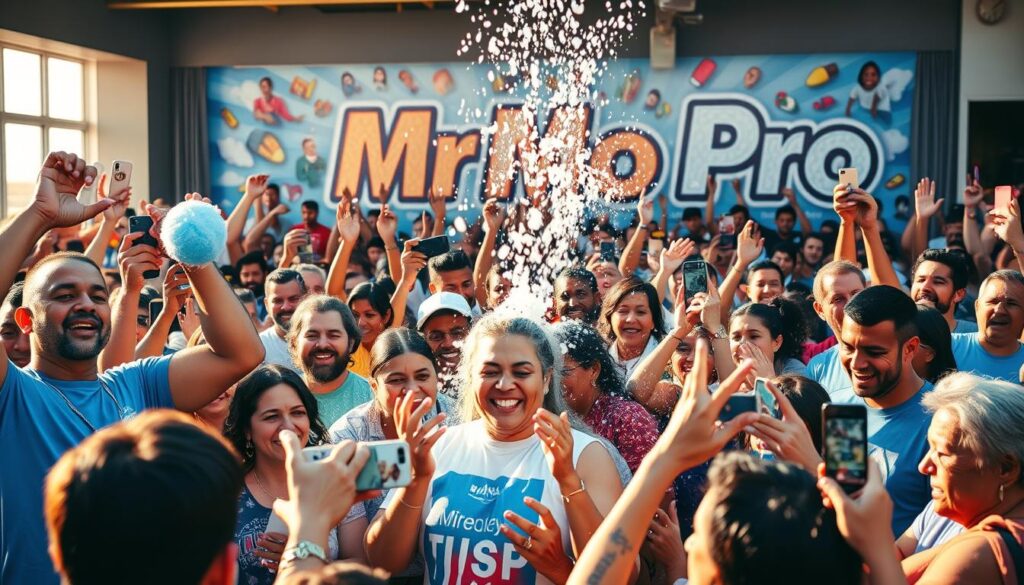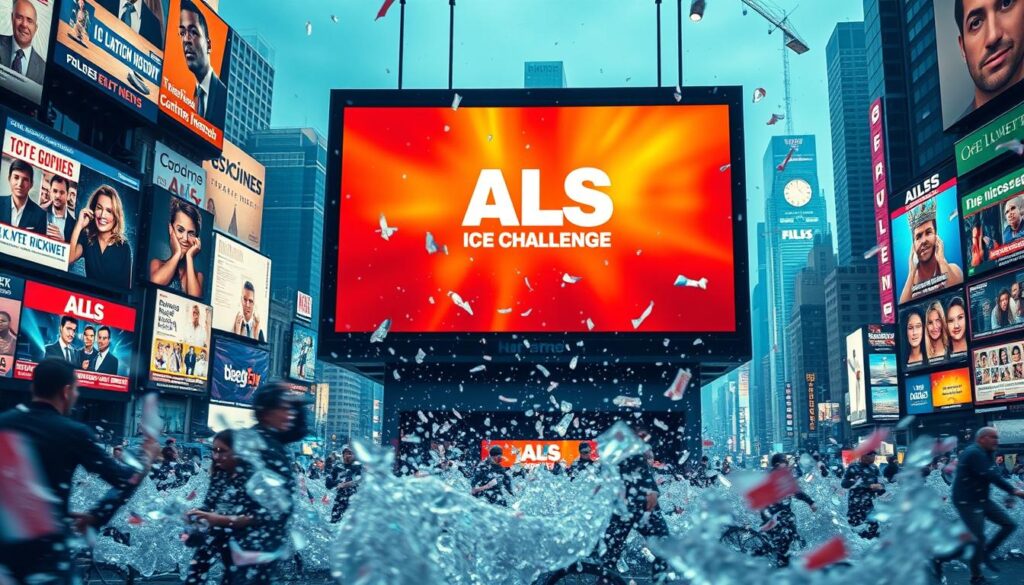
In the summer of 2014, a simple act of pouring ice water became a global phenomenon. Three young men living with ALS sparked a movement that inspired over 17 million people worldwide to participate in the Ice Bucket Challenge, raising a staggering $115 million for ALS research and care.
Social media played a crucial role in turning this challenge into a viral sensation. Platforms like Facebook and Twitter were flooded with videos of people dousing themselves with ice water, using hashtags like #ALSicebucketchallenge. Celebrities and everyday people alike joined in, creating a wave of awareness and donations that no one could have anticipated.
The ALS Association was at the heart of this movement, promoting the challenge and ensuring that the funds raised would directly impact research and patient care. By the end of August 2014, donations to the ALS Association exceeded $100 million, with 67% of the funds allocated to research. This influx of support led to significant advancements, including the discovery of 12 new ALS genes and the approval of two new treatments.
The impact of the Ice Bucket Challenge extended far beyond the funds raised. It brought ALS into the spotlight, increasing awareness and inspiring a new wave of advocacy. The challenge showed the power of social media in driving change and demonstrated how a simple idea could make a profound difference.
History and Origins of the Ice Bucket Challenge
The concept of the Ice Bucket Challenge began long before its association with ALS. Early versions of the challenge involved people pouring cold water over themselves to raise money for various causes, such as cancer research and pet charities.
Predecessors and Early Beginnings
One of the earliest known cold water challenges was the “Cold Water Challenge,” which started as a way to support cancer research. This laid the groundwork for the Ice Bucket Challenge. Local campaigns also played a role, using the idea of pouring cold water to raise funds for different charities.
Television personalities like Matt Lauer helped bring the concept to a wider audience. Their participation made the challenge more mainstream and accessible to a broader demographic.
The Shift Toward ALS Awareness
The shift toward ALS awareness happened through personal stories and early nominations on social media. People began nominating others to take the challenge, and soon, the focus turned to raising funds for ALS research.
Individuals with personal connections to the disease played a crucial role in this shift. Their stories highlighted the need for research and support, making the challenge more meaningful and focused.
Influential figures and media personalities were instrumental in transitioning the challenge to a disease-focused cause. Their involvement helped refine the challenge’s purpose and brought attention to ALS.
| Aspect | Early Challenges | ALS Ice Bucket Challenge |
|---|---|---|
| Purpose | Raise money for various causes (e.g., cancer, pets) | Specific focus on ALS research and awareness |
| Reach | Local and limited online presence | Global phenomenon with millions of participants |
| Impact | Modest funds for different charities | Raised $115 million for ALS research |
The Ice Bucket Challenge’s evolution from a generic cold plunge to a focused ALS awareness campaign was a result of community efforts and early research funding. This shift not only refined the challenge’s purpose but also tied early experiments with water and buckets to the broader narrative of ALS awareness.
ALS Ice Bucket Challenge: Impact on Awareness and Funding
The ALS Ice Bucket Challenge became a cultural phenomenon in 2014, transforming a simple act into a powerful tool for raising awareness and funds. Social media platforms like Facebook and Twitter were flooded with videos of people participating, using hashtags like #ALSicebucketchallenge. This viral movement not only raised over $115 million for ALS research but also significantly increased public awareness of the disease.
Social Media Explosion and Celebrity Involvement
Celebrities and political figures, such as Bill Gates and Oprah Winfrey, played a crucial role in amplifying the challenge’s reach. Their participation drew massive attention, making the campaign more mainstream and accessible to a broader audience. Social media’s role was instrumental, as it turned individual actions into a collective movement, fostering a sense of community and shared purpose.
Record-Breaking Donations and Global Reach
The challenge’s impact was unprecedented, with donations exceeding $100 million within weeks. This influx of funding enabled significant advancements in ALS research, including the discovery of new genes associated with the disease. The global reach of the challenge was evident, with participation spanning across countries and cultures, united by a common cause.
| Aspect | Before the Challenge | After the Challenge |
|---|---|---|
| Funding for ALS Research | $52 million (FY 2016) | $218 million (FY 2024) |
| Social Media Engagement | 1.2 million videos | 2.4 million videos |
| Donations | Typical annual fundraising | $115 million in six weeks |

The success of the Ice Bucket Challenge demonstrated the power of social media in driving change. It not only raised essential funds for ALS research but also inspired a new wave of advocacy and awareness. To learn more about how digital campaigns can enhance your fundraising efforts, visit our guide on e-commerce SEO strategies.
Funding and Research Advances Sparked by the Challenge
The ALS Ice Bucket Challenge led to unprecedented funding for ALS research, sparking significant advancements in understanding and treating the disease. The influx of nearly $90 million globally revolutionized the field, enabling scientists to explore new avenues for treatment and care.
Breakthroughs in ALS Genomics and Clinical Trials
The funds discovered several new genes linked to ALS, including NEK1, a key genetic factor. This breakthrough has deepened our understanding of the disease’s origins. Clinical trials for novel treatments also saw significant progress, offering hope for more effective patient care.

Research organizations played a crucial role, allocating funds to over 275 grants in the U.S. and $8.5 million internationally. These investments led to a 20% increase in scientific publications and a doubling of multidisciplinary clinics. To learn more about the impact of organized funding, visit our research credentials page.
Community and Global Participation in the Challenge
Local communities played a vital role in sustaining the momentum of the Ice Bucket Challenge. Families and grassroots organizations around the world organized events and revivals, ensuring the movement’s continued success. These efforts not only raised funds but also strengthened support networks for patients and their families.
Grassroots Movements and Local Revivals
Grassroots movements were instrumental in keeping the challenge alive, even after its initial viral peak. Local events, from small-town gatherings to global initiatives, demonstrated the power of community involvement. Families and organizations rallied together, creating therapy programs and support networks that went beyond just fundraising.
| Aspect | Local Impact | Global Impact |
|---|---|---|
| Participation | Over 260,000 Canadians joined the challenge, raising $17.2 million for ALS research and care. | Globally, the challenge engaged over 17 million participants, generating $220 million in donations. |
| Research Funding | $11.5 million invested in Canadian research grants. | Worldwide, $154 million funded ALS research initiatives, leading to the discovery of 12 new genes. |
| Support Programs | ALS Canada developed best practice recommendations for ALS management. | Global efforts increased ALS treatment clinics from 100 to 260. |

Personal connections and community therapy programs were essential in supporting patients. Families shared their stories, inspiring others to join the cause. This collective effort not only raised funds but also brought hope to those affected by the disease.
Various program initiatives fostered unity and purpose within the ALS community. From local revivals to global campaigns, every person’s involvement contributed to progress toward a cure. To learn more about effective fundraising strategies, visit our guide on search engine optimization.
The challenge showed that even small actions, when combined, can lead to significant change. As the world continues to seek a cure for ALS, the lessons from this movement remind us of the power of unity and compassion.
Media Coverage and Cultural Impact
The ALS Ice Bucket Challenge captivated the world, drawing significant media attention and leaving a lasting cultural imprint. Its widespread reach was amplified by celebrities and political figures, who helped spread awareness and funds for ALS patients.
Celebrity Endorsements and Political Figures
Prominent figures like Pat Quinn, a key advocate, and celebrities such as Oprah Winfrey and Bill Gates played pivotal roles in the campaign’s success. Their participation not only boosted visibility but also drew in a broader audience, making the challenge a global phenomenon.
Critiques on Water Usage and Engagement Levels
Despite its success, the challenge faced criticism for excessive water usage, particularly in regions facing droughts. However, this scrutiny also kept the campaign in the public eye, highlighting both its impact and the need for mindful resource use.
| Aspect | Media Coverage | Cultural Impact |
|---|---|---|
| Reach | Featured in major media outlets worldwide | Engaged over 17 million participants globally |
| Engagement | Over 2.2 million tweets and widespread social media presence | Significant increase in ALS awareness and donations |
| Critiques | Discussions on water usage and engagement levels | Balanced view acknowledging both success and challenges |

The challenge’s success can be attributed to its strategic use of social media and the involvement of influential figures. For more insights on effective digital campaigns, visit this resource.
Conclusion
The Ice Bucket Challenge left an indelible mark on the world, reshaping the landscape of ALS research and advocacy. This unique movement brought together groups and communities worldwide in a single day, proving that collective action can drive significant change. As a vital resource for ALS awareness, the challenge not only raised over $115 million but also advanced clinical trials and improved care for those living with ALS.
Every participation in the challenge contributed to progress toward a cure and enhanced the quality of life for ALS patients. The campaign’s legacy serves as a powerful reminder of the impact of unity and compassion. By supporting ALS through such initiatives, we continue to foster a movement that transcends time and inspires future efforts to combat this disease.

 ALS Ice Bucket Challenge: The Viral Campaign That Raised $115 Million
ALS Ice Bucket Challenge: The Viral Campaign That Raised $115 Million
0 Comment